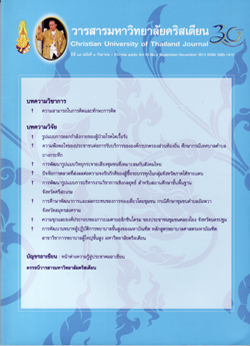ความชุกและองค์ประกอบของภาวะเมตาบอลิกซินโดรม ของประชาชนชุมชนคลองโยง จังหวัดนครปฐม
บทคัดย่อ
ภาวะเมตาบอลิกซินโดรม หรือโรคอ้วนลงพุง เป็นปัญหาสาธารณสุขที่สำคัญทั่วโลกรวมทั้งประเทศไทยเนื่องจากเป็นปัจจัยเสี่ยงของโรคหัวใจและหลอดเลือด การศึกษาครั้งนี้เป็นการวิจัยเชิงสำรวจภาคตัดขวางในกลุ่มประชาชนที่มารับบริการตรวจคัดกรองสุขภาพ ณ โรงพยาบาลส่งเสริมสุขภาพตำบลในชุมชนตำบลคลองโยง อำเภอพุทธมณฑล จังหวัดนครปฐม จำนวน 103 ราย มีวัตถุประสงค์เพื่อศึกษาความชุกและความสัมพันธ์ระหว่างปัจจัยเสี่ยงกับองค์ประกอบของโรคอ้วนลงพุง เครื่องมือที่ใช้เก็บข้อมูลประกอบด้วยแบบสอบถามข้อมูลส่วนบุคคล ประวัติสุขภาพ พฤติกรรมสุขภาพและแบบคัดกรองกลุ่มโรคเมตาโบลิก ของสำนักงานหลักประกันสุขภาพ (สปสช.) ผู้วิจัยเก็บข้อมูลด้วยตนเองด้วยการตรวจร่างกายเบื้องต้น ได้แก่ การชั่งน้ำหนักตัว วัดส่วนสูง วัดความดันโลหิตและการตรวจระดับน้ำตาลในเลือดแบบเจาะปลายนิ้วโดยใช้เกณฑ์การวินิจฉัยและองค์ประกอบโรคอ้วนลงพุง ได้แก่ ระดับความดันโลหิต ระดับน้ำตาลในเลือดและค่าดัชนีมวลกาย ข้อมูลที่สมบูรณ์และนำมาใช้ในการวิเคราะห์เชิงสถิติมีจำนวน 95 ชุด
ผลการวิจัย พบว่ากลุ่มตัวอย่างเป็นเพศหญิง (ร้อยละ 67.40) และเพศชาย (ร้อยละ 32.60) อายุระหว่าง 44-88 ปี (x̄ = 68.02; SD = 8.96) พฤติกรรมเสี่ยงที่พบมากที่สุดคือ การออกกำลังกายไม่สม่ำเสมอและไม่ออกกำลังกายเลย (ร้อยละ 76.80) มีน้ำตาลในเลือดสูง (ร้อยละ 25.30) มีระดับความดันโลหิตสูง (ร้อยละ 32.60) และค่าดัชนีมวลกายสูงกว่าเกณฑ์ (ร้อยละ 37.90) เมื่อวิเคราะห์ความชุกขององค์ประกอบโรคอ้วนลงพุง พบว่ามีผู้ที่มีองค์ประกอบร่วม 2 ใน 3 ข้อจำนวน 28 รายและมีผู้ที่มีองค์ประกอบครบ 3 ข้อจำนวน 3 ราย อย่างไรก็ตาม เมื่อวิเคราะห์ความสัมพันธ์ระหว่างปัจจัยเสี่ยงและองค์ประกอบทั้ง 3 ข้อนี้พบว่าไม่มีความสัมพันธ์กันอย่างมีนัยสำคัญทางสถิติ ผู้วิจัยเสนอแนะให้มีการเร่งรณรงค์จัดโครงการปรับเปลี่ยนวิถีชีวิตและพฤติกรรมสุขภาพโดยเฉพาะการป้องกันภาวะอ้วนและอุปนิสัยในการทำกิจวัตรประจำวันเพื่อป้องกันการเกิดอุบัติการณ์ของโรคหัวใจและหลอดเลือด
เอกสารอ้างอิง
กิตติพงศ์ คงสมบูรณ์ และสุรเชษฐ์ เลิศฐิติพันธุ์. (2553). เมตาบอลิกซินโดรมและปัจจัยที่เกี่ยวข้องในประชากรไทย. สงขลานครินทรเวชสาร, 28(3) : 145-53.
ฉัตรเลิศ พงษ์ไชยกุล และคณะ.(2007). Prevalence of metabolic syndrome and its relationship to weight in Thai population. J Med Assoc Thai, 90 : 459-67.
ชูชัย ศุภวงศ์ สมศักดิ์ ชุณหรัศมิ์ ลัดดา ดาริกาเลิศ และคณะ. (2552). คู่มือการให้บริการของโรงพยาบาลส่งเสริมสุขภาพตำบล. กรุงเทพฯ : บริษัท ที คิว พี จำกัด.
ชัยชาญ ดีโรจนวงศ์ และ ธีระ ไพรัชวิสุทธิ์. (2551). Metabolic syndrome and fatty liver disease. The 3rd Annual Meeting of Liver Society (Thailand).
พรทิพย์ มาลาธรรม และคณะ.(2554). ความชุกและองค์ประกอบของกลุ่มอาการเมตาบอลิคของประชาชนในจังหวัดนครราชสีมา. Thai Journal of Nursing Council, 26(4); 137-147.
เยาวรัตน์ ปรปักษ์ขาม และ พรพันธุ์ บุญยรัตนพันธุ์. (บรรณาธิการ) (2549). รายงานการสำรวจสภาวะสุขภาพอนามัยของประชาชนไทยโดยการตรวจร่างกายครั้งที่ 3 พ.ศ. 2546-2547. กรุงเทพฯ : สำนักงานกิจการโรงพิมพ์องค์การสงเคราะห์ทหารผ่านศึก ในพระบรมราชูปถัมภ์.
รวมพร นาคะพงศ์. (บรรณาธิการ). (2553). แนวปฏิบัติการปรับเปลี่ยนพฤติกรรมสุขภาพเพื่อลดปัจจัยเสี่ยงโรคหัวใจและหลอดเลือด. สำนักโรคไม่ติดต่อ กรมควบคุมโรค กระทรวงสาธารณสุข. โรงพิมพ์สำนักงานพระพุทธศาสนาแห่งชาติ.
วิชัย เอกพลากร. (บรรณาธิการ). รายงานการสำรวจสุขภาพประชาชนไทยโดยการตรวจร่างกายครั้งที่ 4 พ.ศ. 2551- 2552. นนทบุรี : บริษัท เดอะ กราฟิกโก ซิสเตมส์.
ศิรพร ภัทรกิจกำจร และคณะ. (2554). อาการเมตาบอลิคของเจ้าหน้าที่โรงพยาบาลมหาราช นครศรีธรรมราช: การพบความชุกสูงขององค์ประกอบในอาการเมตาบอลิค 1 ถึง 2 ชนิด. วารสารเทคนิคการแพทย์และกายภาพบำบัด, 23: 25-33.
ศิริพร ปรุงวิทยา และคณะ. (2555). ความชุกของสามองค์ประกอบในกลุ่มอาการเมตาบอลิกจากโรงพยาบาลส่งเสริมสุขภาพตำบลท่าสองคอน จังหวัดมหาสารคาม. วารสารเทคนิคการแพทย์, 40(3): 4348-56.
ศิวากร พรตระกูลพิพัฒน์ และคณะ. (2554). ดัชนีความเสี่ยงต่อเบาหวานของไทยรูปแบบประยุกต์กับการคัดกรองกลุ่มอาการทางเมทาบอลิก. ศรีนครินทร์เวชสาร, 26(3) : 213-24.
สำนักงานหลักประกันสุขภาพแห่งชาติ .(2553). คู่มือบริหารงบกองทุนหลักประกันสุขภาพแห่งชาติ 2554 เล่มที่ 4 การบริหารงบควบคุม ป้องกัน และรักษาโรคเรื้อรัง : บริการควบคุม ป้องกันความรุนแรงของโรคเบาหวานและความดันโลหิตสูง. กรุงเทพฯ : บริษัทศรีเมืองการพิมพ์.
สำนักนโยบายและยุทธศาสตร์ กระทรวงสาธารณสุข. (2555). แผนยุทธศาสตร์สุขภาพดี วิถีชีวิตไทย พ.ศ.2554-2563. โรงพิมพ์พระพุทธศาสนาแห่งชาติ.
หทัยชนก บัวเจริญ. (2555). บทบาทพยาบาลในการพัฒนานวัตกรรมเพื่อการจัดการภาวะ Metabolic syndrome แบบองค์รวม. วารสารวิทยาลัยพยาบาลพระปกเกล้า จันทบุรี, 23(1) : 71-80.
Adam T., Alan G. & Stepfanie A. (2008). Outcomes of a multidisciplinary approach to the management of the metabolic syndrome. Canadian Pharmacist Journal, 141(1) : 42-52.
Aekplakorn W., Et al.(2011). Prevalence of metabolic syndrome defined by the International diabetes Federation and National Cholesterol Education Program criteria among Thai adults. Asia Pac J Public Health, 23 : 792-800.
Alberti,KG,, Zimmet,P., Shaw,J. and IDF Epidemiology Task force Consensus Group. (2005). IDF Epidemiology task force consensus group. The Metabolic syndrome-a new worldwide definition. Lancet, 366 : 1059-62.
Alberti,KG, Eckel RH., Grundy SM. Et al. (2009). Harmonizing the metabolic syndrome : a joint interim statement of the international Diabetes Federation Task Force on Epidemiology and Prevention; National Heart Association; World Heart Federation; International Atherosclerosis Society; and International Association for the Study of Obesity. Circulation, 120(16) : 1640-45.
Boonyavarakul, A. Et al.(2005). Prevalence of metabolic syndrome and its association factors between percentage body fat and body mass index in rural Thai population aged 35 years and older. J Med Assoc Thai, 88 Suppl 3 : S121-30.
Carr db. Et al.(2004). Intra-abdominal fat is a major determinants of the National Cholesterol Education Program Adult Treatment Panel III criteria for the metabolic syndrome. Diabetes, 53(8) : 2087-94.
Cheepudomwit,S., Chapman, N., Wooward,M., Grundy SM., Brewer B. and Cleeman,Jl.(2003). Definition of metabolic syndrome. Collaboration study of cardiovascular disease in Asia. Interasia, 87-97.
Choo V. (2002). WHO reassesses appropriate body-mass index of Asian populations.Lancet, 360; 235.
Expert panel on detection, evaluation, and treatment of high blood cholesterol in adults. Executive summary of the third report of the national Cholesterol Education program (NCEP). (Adults Treatment Panel III); Final report. (2001).JAMA, 287; 356-35.
Freire R., Et.al.(2005). Dietary fat is associated with metabolic syndrome in Japanese Brazillians. Diabetes care, 28(7): 1779-85.
Ford ES. (2005). Prevalence of the metabolic syndrome defined by the International diabetes Federation among adults in the US. Diabetes care, 28(11) : 2745-49.
Grundy SM. Et al. (2008). Definition of metabolic syndrome : report of the national heart, lung, and blood Institute/American Heart Association for the Study of Obesity. Circulation, 24 : e13-8.
Haffner SM. Et al. (1992). Prospective analysis of the insulin-assistance syndrome (syndrome X). Diabetes, 41 : 715-22.
Isomaa B. Et al. (2001). Cardiovascular morbidity and mortality associated with the metabolic syndrome. Diabetes Care, 24 : 683-9.
International Diabetes Federation. (2006). The IDF consensus worldwide definition of the metabolic syndrome. Belgium: International Diabetes Federation.
Lloyd-Jones D. Et al. (2010). Heart disease and statistics-2010 update : a report from American Heart Association. Circulation, 121 : e46-e215.
Micheal JB. & Sherita, HB. (2008). A practical approach to the metabolic syndrome. Mayo Clinic Proceedings, 83(8): 932-942.
National Cholesterol education Program Expert panel on Detection, Evaluation, Treatment of High Blood Cholesterol in Adults. (2002). Third Report of the National Cholesterol education Program (NCEP) Expert panel on Detection, Evaluation, Treatment of High Blood Cholesterol in Adults (Adults Treatment Panel III) final report. Circulation, 106(25) : 3143-421.
Palacios-Rodriguez RG., Et al. (2010). Metabolic syndrome in health care personnel from a primary care unit. Rev Med Inst mex Seguro Soc, 48(3) : 297-302.
Pan XR. Et al. (1997). Effects of diet and exercise in preventing NIDDM in people with impaired glucose tolerance: the Da Qing IGT and Diabetes Study. Diabetes Care, 20 : 537-44.
Pongchaiyakul C. Et al. (2006). Defining obesity by body mass index in the Thai population : an epidemiologic study. Asia Pac J Clin Nutr, 15(3) : 293-9.
Ravaglia G.(2006). Metabolic syndrome : Prevalence and prediction of mortality in elderly individuals. Diabetes Care, 29(11) : 2471-76.
Scuteri,A., Et.al.(2005). The metabolic syndrome in older individuals : prevalence and prediction of cardiovascular events. The Cardiovascular Health Study. Diabetes Care, 28(4) : 882-7.
Smith, C.M. & Maurers, F.A. (2000). Community health nursing : Theory and practice. (2nd editions); Philadelphia : W.B. Saunders Company.
Tan CE., Ma S., Wai D., Chew SK., and Tai ES.(2004). Can we apply the National Cholesterol Education Program (NCEP) Adults Treatment Panel definition of the metabolic syndrome to Asians? Diabetes Care, 27 : 1728-34.
Wong ND. (2005). Intensive screening and treatment of the metabolic syndrome for cardiovascular risk reduction. Prev Cardiol, 8(1) : 47-54.
WHO expert consultation. (2004). Appropriate body mass index for Asian populations and its implications for policy and intervention strategies. Lancet, 363 : 157-63.



